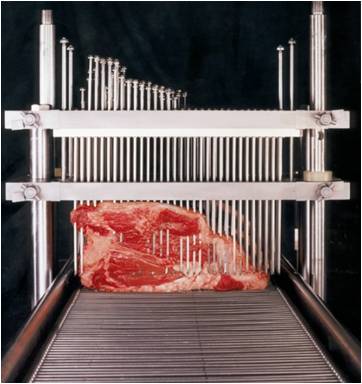On March 20, 1996, British Health Secretary Stephen Dorrell rose in the House to inform colleagues that scientists had discovered a new variant of Creutzfeldt-Jacob disease (CJD) in 10 victims, and that they could not rule out  a link with consumption of beef from cattle with bovine spongiform encephalapthy (BSE), also known as mad cow disease.
a link with consumption of beef from cattle with bovine spongiform encephalapthy (BSE), also known as mad cow disease.
Overnight, the British beef market collapsed and politicians quickly learned how to enunciate BSE and CJD. Within days, the European Union banned exports of British beef; consumption of beef fell throughout Europe, especially in France and Germany, and in Japan, where suspicion of foreign food runs high. The triumvirate of uncertain science, risk and politics was played out in media headlines.
To refer to the events of 1996 as the BSE crisis is a misnomer, just as scientists are quick to point out that mad cow disease should more appropriately be called sad cow disease or unco-ordinated cow disease. Rather, the announcement of March 20, 1996 was the culmination of 15 years of mismanagement, political bravado and a gross underestimation of the public’s capacity to deal with risk. More important than any of the several lessons to be drawn from the BSE fiasco is this: the risk of no-risk messages. For 10 years the British government and leading scientific advisors insisted there was no risk — or that the risk was so infintesimly small that it could be said there was no risk — of BSE leading to a similar malady in humans, CJD, even in the face of contradictory evidence. The no-risk message contributed to the devastating economic and social effects on Britons, a nation of  beefeaters, the slaughter of over 1 million British cattle, and a decrease in global consumption of beef, especially in Japan, at a cost of billions of dollars.
beefeaters, the slaughter of over 1 million British cattle, and a decrease in global consumption of beef, especially in Japan, at a cost of billions of dollars.
The Canadian Minister of Agriculture was quite adamant there was no risk of BSE developing in Canada.
In July 1996, Dr Norman Willis, Director General, Animal and Plant Health, Agriculture and Agrifood Canada, told the Canadian Veterinary Medical Association’s annual convention that “Actions were taken out of sheer paranoia, with people significantly hyped by the media. We took actions that went way beyond ones that were scientifically justified. … We wouldn’t have political interference. We wouldn’t have non-science factors influence the actions we took. BSE blew that all away. … Canada and other trading countries couldn’t hold with science-based decisions. There was just too much at stake by way of trade.’’
Canada’s initial dragging to the grown-up’s table of BSE risk management, and apparent lax enforcement of feed regulations for years afterwards led to the inevitable: On May 20, 2003, Canada announced its first home-grown case of BSE.
The eight-year old cow from Alberta had been condemned at slaughter, was sent for rendering and did not enter the food chain.
The first few chapters of the story about the discovery of BSE in Canada were positive.
BSE was bound to show up eventually and the surveillance system set up in 1992 sorta worked. The inspector who pulled a sickly looking eight-year-old cow from the slaughter line prevented it from entering the food chain.
The line in Canada was, this is not the UK, and I was on TV at 5 a.m. the next morning, saying the U.K., had some 186,000 cattle test positive and millions preemptively slaughtered. The significant question was, will Canadian numbers of BSE-positives remain in the dozens or the tens-of-thousands (or something like that).
And yes, producers, processors and government should have been fully aware of the risk rather than act stunned when it happened.
Ten years on, with the perspective that time often offers, my statements seem accurate but naïve.
Canada has since reported 18 cases of BSE, and, just like other aspects of food safety, those in charge talk a good line, but do they know what really  happens on farms (or anywhere) day-in, day-out.
happens on farms (or anywhere) day-in, day-out.
And are they interested? Because being interested costs money.
Ian Gray of the Edmonton Journal wrote a 10-year-retrospective piece on the first homegrown BSE case today, beginning with:
In January 2003, Marwyn Peaster’s cow fell down.
The six-year-old Black Angus was one of a small herd Peaster had bought the year before for his grain farm and feedlot near Wanham, in Alberta’s Peace Country.
Believing the cow had pneumonia, Peaster made the fateful decision to send it to a local abattoir instead of calling for a veterinarian or disposing of it on his own property. The vet at the slaughterhouse went by the book and condemned the “downer” cow, so there’d be no chance it could be used for human consumption.
The carcass then went to a rendering plant, but the head was sent to a provincial laboratory in Edmonton for testing. As there was no perceived urgency, there it sat, until May 16, 2003.
Three and a half months after it was shipped, the head was finally tested at the provincial lab and, to the disbelief and horror of everyone involved, registered positive for BSE. The results were confirmed by federal and international laboratories and were announced to the public on May 20.
As of May 1, 2013, vCJD had killed 237 people worldwide.
The attack on Peaster reached its peak that September with the now infamous remark by then-premier Ralph Klein that “any self-respecting rancher would have shot, shovelled and shut up, but he (Peaster) didn’t do that.”
Peaster has since moved back to the U.S. and is living in the farming community of Ontario, Oregon, where he has a small trucking company. True to form, he has no desire to comment on the 10th anniversary of the discovery of BSE in Canada, in which he was a key, if unwilling, player.
Mad cow no longer dominates the food safety headlines, and that’s good. The potential is always there, and requires good risk management, but a lot more people get sick from lots of other things associated with beef (although vCJD is a terrible way to die).
As the elementary school year wound down in June, 2003, in Ontario, Canada,
the school three of my four daughters attended had a barbeque for students, staff
and parents.
The earlier discovery of Canada’s first domestic case of bovine spongiform
encephalopathy which received
extensive media coverage, was of concern to some parents and school
officials, so a note was sent home to parents, assuring them that the
hamburgers and hot dogs to be consumed came from a supplier of so-called
natural, beef and was therefore safe from BSE.
At this particular BBQ, several of the well-meaning volunteer cooks were
observed to handle the raw, natural hamburger patties with tongs that were
then used to place re-heated wieners into hot dog buns, possibly
cross-contaminating the wieners with any number of pathogenic microorganisms
![HappyCow[1]](https://barfblog.com/wp-content/uploads/2013/05/HappyCow1-239x300.jpg) such as E. coli O157:H7, salmonella or listeria, and subsequently served to
parents and children.
such as E. coli O157:H7, salmonella or listeria, and subsequently served to
parents and children.
About the same time, a bunch of industry folks hosted a BBQ on Parliament Hill in Ottawa, to demonstrate the safety of Canadian beef to politicos.
I watched the servers cook burgers, not use thermometers, and cross-contaminate everything in sight.
I asked, where is the hamburger form?
Don’t worry, it’s not from Alberta, no mad cow here.
Are these pre-cooked?
Nah, they’ve been sitting in the (non-refrigerated) truck for a few hours.
I always wondered if anyone got sick after that feast.
 Public Health Agency of Canada or Health Canada (who knows the difference).
Public Health Agency of Canada or Health Canada (who knows the difference).







![HappyCow[1]](https://barfblog.com/wp-content/uploads/2013/05/HappyCow1-239x300.jpg)






